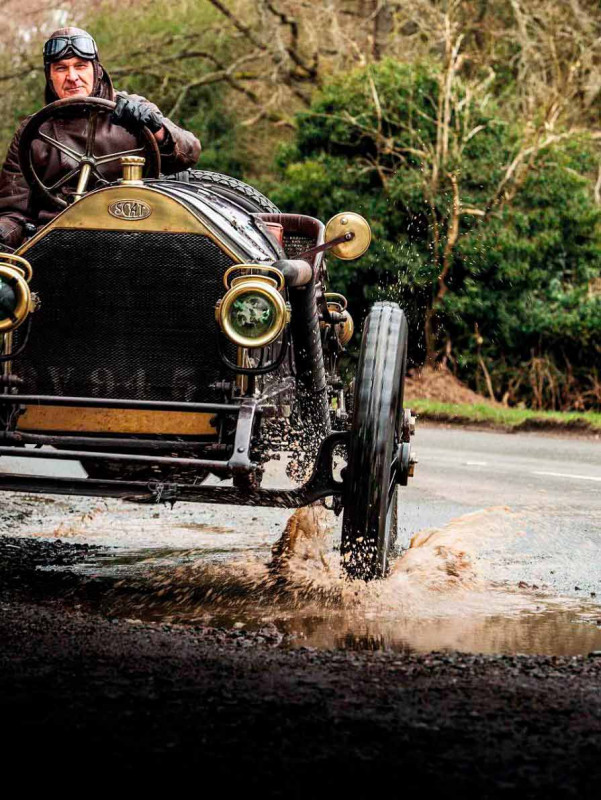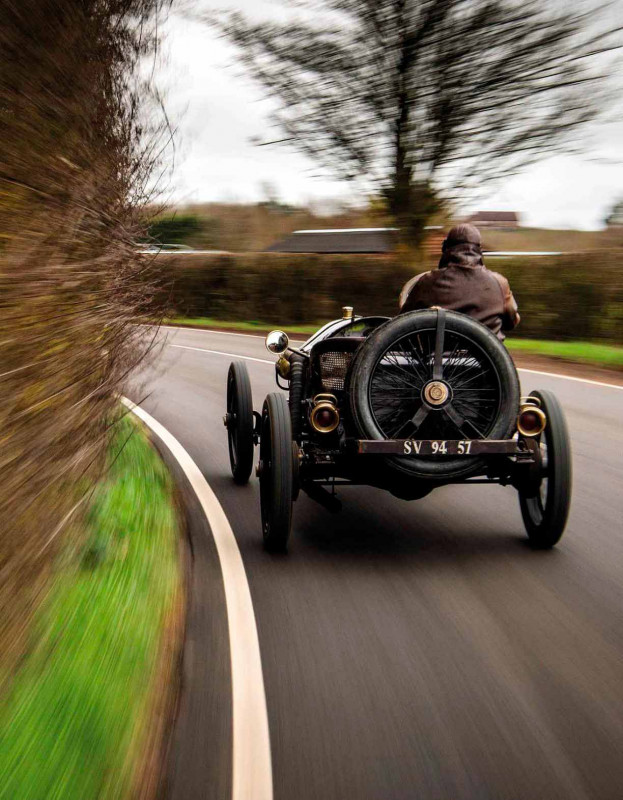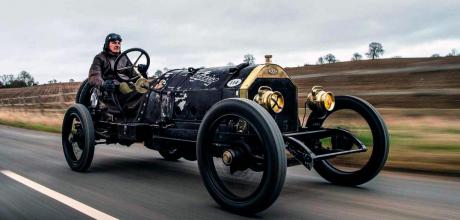9.2-litre 1911 SCAT
A 9.2-litre engine and all the mod cons of an Edwardian racer make this 1911 SCAT a handful to say the least. Zack Stiling takes on the challenge of mastering it Photography Aston Parrott.
EDWARDIAN RACER
9.2-litre engine makes the 1911 SCAT a handful
IN AT THE DEEP END
They were the founding fathers of the Italian motor industry and a formidable presence in gruelling early car races, but, buried beneath all the derring-do about Ferraris, Alfa Romeos and Maseratis, the family name Ceirano is hardly a household one.

Giovanni Battista (henceforth ‘Giovan’) Ceirano arrived in Turin in 1880 to manufacture and market bicycles under the Welleyes name. Following the example of Peugeot and several British marques, Ceirano GB & C made the natural progression to motor vehicle production and, in 1899, it built the first Welleyes cars. Its factory proved insufficient to cope with demand, however, and after only a few weeks the designs were sold to Giovanni Agnelli and the first FIAT was born. After the Welleyes, Giovan and his younger brothers, Giovanni and Matteo, were variously responsible for the creation of another halfdozen or so new marques, one of which was SCAT – Società Ceirano Automobili Torino – founded by the younger Giovanni in 1906 and financed by the Manchester firm of Newton & Bennett.
‘This SCAT has a relatively modest 9.2-litre engine. It is the sensible face of Edwardian specials’

The early SCATs were large, high-quality touring machines, altogether a safe purchase for your typical speed crazed Italian count. The 22/32hp model of 1907 boasted an engine of 3770cc, which grew to 4398cc in 1910. It was refined and powerful enough to rival Lancia, Isotta Fraschini and Itala, but it lacked an achievement necessary for real glory: victory in the Targa Florio.
Giovanni’s son (also Giovanni but known as Ernesto) drove a 22/32hp SCAT in the 1911 Targa Florio with a view to addressing that. He had raced in previous Targa Florios for other Ceirano family marques including Itala and SPA, but SCAT was inexperienced in competition so victory wasn’t assured. However, his completion of the three laps (277 miles) at an average 29mph made him faster than anyone else. SCAT repeated its victory in 1912 with Cyril Snipe driving a 25/35hp, and Ernesto won again with a 22/32hp in 1914, lapping Sicily in under 17 hours at 36mph.
‘References to its scariness aren’t reassuring: just looking at the SCAT makes you apprehensive’
It was with the Targa Florio in mind that Andrew Howe- Davies’s 1911 SCAT was created, albeit not in period. It came into being only when the derelict chassis was discovered in Australia and identified as a promising platform for a VSCC Edwardian special. Eschewing an aero engine – cars like that are great, but they’re not exactly practical – this one has a relatively modest 9.2-litre, assembled from parts that were always intended for cars. It can be driven happily through the English countryside, and the fuel bills needn’t be dreaded too much. This SCAT, then, is the sensible face of Edwardian specials.

Howe-Davies’s car was recovered from Adelaide in 1989, but it passed through several owners before Richard Black acquired it in 2001 and committed to making something of it. While it had sported a heavy tourer body when new, nothing remained of that which could be saved, and the old 22/32hp engine wasn’t in any fit state for use, having thrown its crank through the side of the block. With little left to preserve, Black did what many of us would have done and constructed a Targa Florio-inspired racing body, with a stout 9236cc Simplex four-cylinder from 1910 bolted in place, in essence an early version of an American LaFrance engine. The original engine remains in this country. Says Black: ‘It would be nice to get it one day, but it wouldn’t be anywhere near as good as the Simplex.’
Simplex engines were made by the Simplex Automobile Co of New York, formerly the Smith & Mabley Manufacturing Co. It was more or less a facsimile of the Mercedes Simplex unit. These early engines relied on splash lubrication, unlike those used in American LaFrances, which featured an oil pump. It’s a huge lump of iron, its cylinders cast in pairs with pistons 5½inches in diameter.
Black also fitted a four-speed gearbox from a 1908 Darracq, which he praises. ‘It’s so light for its day. The gearchange is a delight.’ A 2:1 step-up ’box has been fitted ahead of the gearbox, and the torque tube cut down for it all to fit the chassis, with a new connection to the rear axle.
Black sold the SCAT to Martin Shelley in 2004, and Andrew Howe-Davies bought it from him in 2007. His name crops up regularly at veteran and vintage race meetings, but it hasn’t always been so. ‘I was thinking of retiring from my job at the time and looking for something vaguely to do with motorsport,’ Howe-Davies explains. ‘I did stock-car racing when I was a lad but hadn’t done anything since I was 18 or 20. I was interested in a Wolseley Hornet Special and bought a Frazer Nash, but I had to hand it back to the seller because I couldn’t fit in it.
‘Nick Pellett mentioned that there was this SCAT for sale near Edinburgh. I went to see Martin Shelley, we drove to the pub in it and I said, “Right, that’s it.” You just can’t not smile when you’re driving it. I bought it without knowing anything about SCATs, just because I liked it.’
While the SCAT behaved nicely on saunters to the pub, it was less delightful under hard driving. The modified Mini fuel pump had packed up and, when he stripped the engine to examine the splash lubrication, Howe-Davies discovered the big ends were loose and falling apart. And when racing, the step-up ’box would overheat to the point that you couldn’t touch it. ‘It was almost melting. I put an oil-flow system between the main gearbox and the step-up ’box, then I had to redo the crown wheel and pinion, all of which has made it a good car. The suspension wanted to twist too dramatically so I fitted stabilising arms; the torque will break your arm effortlessly. The only thing I haven’t got round to doing is the brakes, but they’re part of the charm.’
All that work has paid off. ‘You have to suck up your loins when you drive it!’ says Howe-Davies. ‘It’s been to Sicily and is fun on those sorts of roads. It’s a unique experience getting onto the Montlhéry banking with no sides. You feel very exposed, like you’re wing-walking. I started racing almost immediately, as its raison d’être is VSCC Edwardian races. Since I bought it, I’ve been out every year doing hillclimbs, sprints and races. I’ve raced a few other bits and bobs, but this still ticks the box. It’s the openness, fragility and scariness of it. You still ask yourself “What am I doing?”’
There’s not much he isn’t happy with, but the carburettor induces some annoyance. ‘When I bought it, it had a very weird Zenith. It must have come from a boat, but it was untunable. Now it has a 48mm Zenith but I need to find another one. VSCC Prescott is my favourite event but I always lose one or two seconds due to the carb, because it has a side float so,when you turn a corner, fuel is pulled away from the jets and it coughs.’
Repeated references to the SCAT’s scariness aren’t reassuring: just looking at this car is enough to make you apprehensive. As a starry-eyed enthusiast separated by over a century from the drivers who raced in period, I had elevated them in my mind to some sort of superhuman ideal, a semi-mythical race of Titans whose boots I am not worthy to fill. So it’s refreshing to discover that my reservations are misplaced.
Howe-Davies runs me through the starting procedure, which is straightforward as it has coil ignition and a starter button. The ignition is advanced to 36º on the road, which is fairly extraordinary, but Andrew advances it even further to 48º when racing. There are two sparks in each cylinder, from the coil and the magneto. Howe-Davies tells me: ‘The tricky thing is to get the mall at the same firing point because of the distance between them. I used to get valve-bounce like mad but I’ve uprated the springs and that’s transformed how the engine runs.’
The engine has a loud, lazy idle, and when the accelerator goes down the noise is as ear-splittingly thunderous as you might expect, but it’s not noticeable when you’re concentrating on controlling the monster. The gears are fantastically long, with first good for 40mph, and in town traffic you could happily go everywhere in second. Much more than that and third feels natural, while in fourth it lopes along effortlessly at around 300rpm, with so much unspent power waiting to be unleashed.
The crash gearbox is very friendly to the novice, allowing Some margin for error, and with its skinny tyres, the steering is as light as a feather. The brakes are not worse than an Austin Seven’s and, while the suspension is hard and you’re bounced around rather a lot, this is another fact to which you’re oblivious as the wind chills your face and you concentrate on reading the road ahead of you.
I must be unconsciously tense, and Howe-Davies comments on my ‘driving school pupil’ manner of gripping the steering wheel, which I might attribute to the fact that the gearlever being on the right is more than a touch disorienting, and the size of the wheel and the large distances between all the controls gives me the feeling of being slightly dwarfed by the car.
Really, though, there’s nothing to be afraid of. The SCAT’s rough exterior and ferocious thunder conceal a rather gentle temperament, although that’s not to suggest anyone could do Howe-Davies’s job of racing it. The experience of country lanes at 35mph is obviously very far removed from that of dicing with an entire field of overpowered, underbraked Edwardians at 70mph.
In races, the SCAT is highly competitive. ‘It’s got a very light chassis for its engine, which makes it a good performer. I’m not quite in the A-class, but I’m in the B-plus. Even though it’s 9.2 litres, it’s a baby next to the 20-litre cars. I thought it might be equal with the Blitzen Benz, until Ben Collings started driving it and went twice as fast.’
Cars such as Mark Walker’s Darracq and Duncan Pittaway’s Fiat S76 give him a target to aim for. ‘I’ve overtaken them once or twice, in moments of luxury. I can catch them on the corners, but on the straights they just go “Bye!”’
There, in a nutshell, are the joys of the Edwardian racer. The thrill is like nothing else, it’ll outperform a lot of modern cars and it could even be called practical, if you’re not averse to getting your hands dirty occasionally. For touring, it’s comfortable and you can easily jump in and do 1000 miles, so Howe-Davies says. ‘You just learn to be very pragmatic about arrival times.’
Above and below Owner Andrew Howe-Davies admits to feeling ‘exposed, like you’re wing-walking’ while driving his SCAT special, yet also claims it’s comfortable enough for a 1000-mile tour.
1911 SCAT
- Engine 9236cc Smith & Mabley Simplex bi-bloc four-cylinder, T-head sidevalve, single Zenith 48mm carburettor
- Max Power 80bhp
- Transmission 1908 Darracq four-speed manual, rear-wheel drive
- Suspension Front: beam axle, semi-elliptic leaf springs, Hartford friction dampers.
- Rear: live axle, semi-elliptic leaf springs, Hartford friction dampers
- Brakes Drums
- Weight 1250kg
- Top speed c100mph
- 0-60mph c8-10sec
This page and opposite The SCAT marque came from the same people that brought you Itala and SPA, not to mention the first FIATs – but this one is notable for being a special, based on a derelict chassis, and fitted with an engine roughly three times the usual size….


